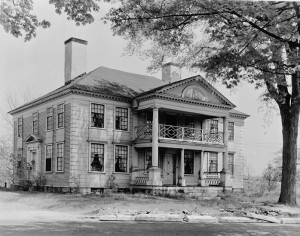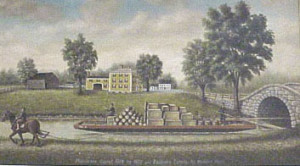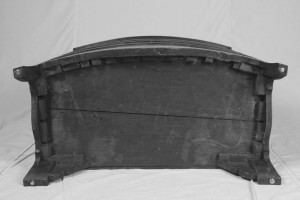by Martin Willis
A look at how antiques connect us to forgotten lives of the past

I was walking my dog this morning on the property of the 1790 House, which is a fine colonial structure in Woburn, Massachusetts that houses the auction company’s office. The property is right next to Rt. 128, which is always very noisy with a constant stream of traffic flowing north and south.
The historic house borders the Middlesex Canal, which was a concept that became a reality in the late 18th century. The canal connected Boston Harbor to the Merrimack River and had 20 locks with the average depth of 3 feet. Barges pulled by oxen transported many goods all the way to Concord, NH and back. The main function of the canal was to transport timber for shipbuilding from the virgin forest of New Hampshire to Medford, Mass. When the canal was built, it was a very substantial feat of engineering for that time.
 As my dog and I walked near the canal, we came to some brush that my dog decided to walk into. I forced my way through the thicket to find my dog, and came upon a magnificent chiseled granite post protruding out of the ground. It had a hand hammered and rusted iron eyelet near the top for rope lashing. I wondered when the last time was that someone saw this post lost in time. I realized that objects like these, along with antiques are connections to the forgotten lives of the past.
As my dog and I walked near the canal, we came to some brush that my dog decided to walk into. I forced my way through the thicket to find my dog, and came upon a magnificent chiseled granite post protruding out of the ground. It had a hand hammered and rusted iron eyelet near the top for rope lashing. I wondered when the last time was that someone saw this post lost in time. I realized that objects like these, along with antiques are connections to the forgotten lives of the past.
I started wondering what it would be like, slipping back in time to the day that the men set the post. The sounds of the busy traffic almost faded away to the sounds of horses, conversations and the hard manual labor. I could almost see and hear the men struggling to set that post in place. I began to wonder what their world was like when they woke up that morning and what was happening all around them throughout that very day.
When I think of the construction of furniture of the same period, similar thoughts come to mind. A piece of furniture is the evidence of the hands of the past that created it. I can slip back in time again through wonder of what the life of the cabinetmaker was really like. I can wonder what was going on in a single day that he was working on a particular piece and what the conversations were like as he practiced his forgotten craft. I am sure what was said was very different from today, yet the same in many ways. I can wonder about the cabinetmaker’s sense of humor, as well as the hardships and struggles of New England life that was shaping his thoughts.
 I can only imagine what a workshop in Massachusetts was like in the late 18th century. I picture sunlight through windows that streams through the smoke filled air with the smell of wood being freshly worked. The sounds of hand planing and a crackling fire that attempts to take a chill off the bitter cold.
I can only imagine what a workshop in Massachusetts was like in the late 18th century. I picture sunlight through windows that streams through the smoke filled air with the smell of wood being freshly worked. The sounds of hand planing and a crackling fire that attempts to take a chill off the bitter cold.
When I think of these pieces, I appreciate the beauty of design, the mastery of work, as well as the long-lasting attributes they have, all because they were made with such care and skill. I think of the tools they had, the lighting and the monumental task of creating a piece from tree to completion without the use of a single machine.
 When I turn a piece upside down to examine it, I can view the oxidation brought on by the many years. I can touch the hand-hewn glue blocks, feel the plane work, scroll saw, and chisel work. Sometimes I can see writings, notes and measurements scribbled in chalk or graphite. These are part of the many signs of the hands that carefully worked the piece all those years ago. If I am quiet enough, I can almost hear the conversations and see and see the cabinetmaker at work, the sunlight streaking through the windows of the smoke filled shop with smells of freshly worked wood.
When I turn a piece upside down to examine it, I can view the oxidation brought on by the many years. I can touch the hand-hewn glue blocks, feel the plane work, scroll saw, and chisel work. Sometimes I can see writings, notes and measurements scribbled in chalk or graphite. These are part of the many signs of the hands that carefully worked the piece all those years ago. If I am quiet enough, I can almost hear the conversations and see and see the cabinetmaker at work, the sunlight streaking through the windows of the smoke filled shop with smells of freshly worked wood.
I thank my dog for running off into the brush this morning. He reminded me of my love for antiques and made me ponder forgotten lives. Reminding me I can observe and touch these pieces that show signs of their journey and the people who cared for them through time.
I truly enjoyed this I love any thing old,some times I think I was born in the wrong era, lol
I remember when I bought my first china head doll. Holding her, I thought of the very first little girl who held her back in the 1860s. Thank you for this beautifully written reminder of why we do what we do for a living.
For the most part, the computer age has isolated the younger generation to observe and take a moment to reflect on the past. To treasure pieces of history as you write so wonderfully about.
Thank for for this wonderful blog and let’s hope that all these pieces you speak of do not become meaningless and lost in time.
Thank you for this post Martin. It’s great that you allowed yourself the time to stop and reflect on your discovery. So often we don’t. You’d be a great museum curator or exhibition curator.
Thank you for taking me away from today and back to a time I have often wondered about myself.
When I see some of the 18th century pieces at the MFA, I am astounded at what was accomplished with hand tools.
I will now, when I go back and look at them again, not only picture the artisan hard at work, but I will also smell that fire and hear that plane moving methodically across the wood.
Beautiful piece, Martin- Thank you.